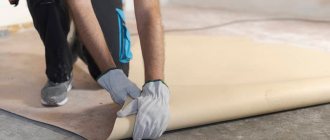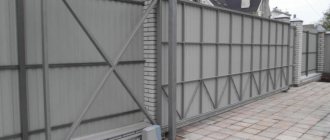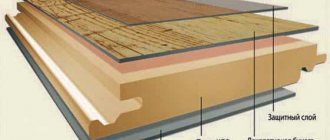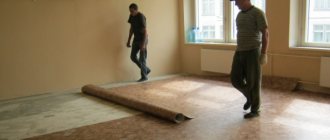Types of linoleum
How to calculate linoleum for a room
How to prepare the floor before laying the covering
What is a substrate, is it possible to do without it?
Adhesive for linoleum
Types of laying linoleum
- Simple flooring
- Using adhesive
- Using double sided tape
Before installation, it is worth determining the type of flooring you will be working with and the technique: for example, whether you will use linoleum underlay on a concrete floor.
Types of linoleum
Today, many manufacturers offer two options for flooring: natural - marmoleum and artificial. The first, although more expensive, is eco-safe and highly wear- and fire-resistant.
Artificial comes in four types:
- Polyvinyl chloride is the most common. Made in various colors and textures. It is divided into commercial, household and semi-commercial. Household and semi-commercial products are suitable for residential premises; they can be laid independently.
- Rubber relin based on rubber is used in the finishing of public institutions, on sports grounds, as well as in industries.
- Alkyd or glypthal type of coating, made from alkyd resins, has excellent heat and sound insulation characteristics. However, it is rarely used in residential areas because it is not fire resistant, does not tolerate low temperatures well, and shrinks easily, resulting in cracks.
- Colloxylin or nitrolinoleum has a high degree of elasticity and wear resistance. However, it is highly flammable, so this type of coating is not used for domestic purposes, or in children's institutions.
Instagram @bestboden
Polyvinyl chloride is one of the most popular types of linoleum. Made in various colors and textures. It is divided into commercial, household and semi-commercial.
- Floor
How to lay linoleum on a wooden floor: instructions and tips for a beginner
How to calculate the required quantity
It's actually quite easy to do. The main thing is to calculate the area of the room that you plan to cover. It is important to consider doorways and spaces under windows.
When purchasing, pay attention to the width of the roll to avoid joining. Most manufacturers offer marmoleum with a width of 2 meters, but there are also samples of 2.5 meters. As for PVC coating, there is more choice here, in the range from 1.5 to 5 meters.
Experts recommend purchasing linoleum with a margin of 10 cm on each side. If the material has a pattern, the supply may be larger.
Instagram @stroytorg_barnaul
Make sure that the product is from the same batch and there are no discrepancies in color. This can be checked by the roll number. It is better to purchase linoleum with a margin of 10 cm on each side.
Requirements for bases for laying linoleum
The base surface must be smooth, hard and dry. Oil stains, dust, dirt, peeling and loose areas are not allowed.
The maximum permissible humidity is 8%. To check, you can use a method based on water evaporation. A piece of plastic film is secured to the floor with tape overnight and removed in the morning. If the screed is not yet dry enough, condensation will form on the film.
The following are used as grounds:
- screed made of cement-sand mortar;
- expanded clay concrete;
- sawdust concrete;
- aerated concrete;
- particle boards or fibreboards;
- mineral wool tufted mats on paper or in a synthetic bond;
- old linoleum coverings.
When checking with a two-meter rod, irregularities of more than 2 mm should not be detected. The base for mastics must be primed for better adhesion of materials. Laying of coatings begins after the primer has completely dried.
How to prepare the floor before laying
Laying linoleum on a concrete floor begins with preparing the base, even if you plan to use a substrate. High-quality preparatory work is the key to long service life of the flooring.
The first thing to do is evaluate the rough coating. It is believed that this material is able to withstand minor irregularities and chips. However, in reality, all this, of course, reduces its service life: concrete sand and dust increase friction between the floor and the deck, which leads to wear and tear of the material and the formation of cracks.
- If the subfloor is uneven, has a difference in levels, crumbles and has large cracks, builders advise removing it completely and then making a new screed. You can use cement, gypsum or self-leveling mixtures.
- Small cracks expand and are filled with mortar.
- The entire surface is primed.
- The rough coating must be clean. It is advisable to wash it and let it dry.
- Simply laying linoleum on concrete is not suitable for everyone, because the floor will be cold. It is worth taking care to protect the structure from moisture and thermal insulation.
Instagram @alexandr_v_k
A new screed is necessary if the floor is uneven or has cracks. The rough coating must be clean. It is advisable to wash it and let it dry.
Preparing the base
Preliminary work is very important.
Modern multi-storey buildings are equipped with floors made of high-strength concrete slabs. The final coating is laid on a solid base. To lay the canvas, preliminary preparation of the concrete floor for linoleum is required. First of all, we need complete dismantling of the old fabric and insulating layer. Then the surface is cleaned from dust, debris, and any contamination. Next, a screed is performed, which can be “wet” or “dry”.
Wet screed
Leveling with a solution is necessary for high-quality installation of the material. Procedure:
Screed with a mixture of cement and sand
- Remove the old coating, clean the concrete surface from dust, dirt, and debris;
- Apply sealant to the joints near the walls. Small cracks are sealed with cement mortar, large cracks are filled with foam;
- Lay a layer of waterproofing. The film is overlapped, slightly extending onto the walls;
- Lay the expansion tape along the walls. This is necessary in case of thermal expansion of the hardened coating;
- Mark the height of the future screed. The operation is performed using a level. The device shows a horizontal line on the wall, which is repeated with a pencil or thread. You need to determine the highest point on the concrete floor, then measure 3 cm up. This is the level of the future flooring;
- Install a perforated profile that will serve as a beacon. The height of the elements is adjusted by wedges. Wood chips or special construction tools are used here;
- Prepare the pouring mixture. The solution is mixed using an electric drill with a special attachment;
- Let the finished mixture sit, then gradually fill the areas between the beacons. The solution is poured first at the far walls, then the excess is distributed to free places using a metal rule. The edge of the instrument rests on the tops of the beacons;
- Wait until the screed has matured. At this time, the room is not ventilated. Sometimes the laid mortar is spilled with water.
Leveling the surface with a self-leveling mixture
After the solution has matured, some irregularities often form on the surface of the base. Whether they need to be corrected or not depends on the type of linoleum being laid. The coating has a thick soft base, with a springy backing, which automatically eliminates minor differences in height. Laying thin linoleum on a concrete floor requires careful leveling of the base with a special water-soluble mixture.
This material is also used in self-leveling floors.
The solution itself spreads over the concrete base under the influence of gravity and does not require special leveling. After pouring, the surface is treated with a spiked roller. To reach the far corners with the tool, spiked shoes are required. After the mixture has hardened, the floor is primed twice.
Dry screed
Leveling a concrete base without using a liquid solution is done as follows:
- Remove old coating from concrete floor. Clean the surface from any dirt or debris;
- Apply sealant to the joints near the walls. To seal large cracks, polyurethane foam and a cement-sand mixture are used;
- Lay a waterproofing film. The edges of the material need to be brought slightly onto the wall;
- Place the beacons in the same order as for pouring the solution;
- Fill the space between the beacons with fine expanded clay or other insulation. Level the surface with a metal rule;
- Lay sheets of gypsum fiber board or any thick dense plywood on top of the beacon profiles. The slabs are laid in two layers so that the joints at different levels are further away from each other. Specially adapted floor elements equipped with a locking system are available for sale.
The process looks something like this
Underlay: a waste of money or a necessity?
Some builders, before gluing linoleum to a concrete floor, advise laying a backing. Others are sure that this is not at all necessary. Who is right? Both sides, in fact, it all depends on the specific room.
Why do you need a substrate?
- It provides good sound insulation, which is especially important in multi-storey buildings.
- One of the key advantages is thermal insulation, which is required for concrete floors in private houses, in children's rooms and, in general, in apartments located on the lower floors.
- Finally, it will help smooth out small ridges, dips, and uneven spots in your subfloor. However, if there are major shortcomings, you should not count on this.
There are several types of substrates depending on the material of manufacture.
- Jute insulation is an environmentally friendly material; it is made from linden fibers. To avoid the formation of mold and rotting, the substrate is impregnated with a special solution. The advantages of such insulation include the ability to absorb moisture and durability.
- Another eco-friendly option is cork, made from crushed cork tree bark. It also provides excellent sound and heat insulation, but is a rather soft and expensive material. Its use as a base for linoleum is not always economically justified.
- Linen insulation consists of rolls, mats or slabs impregnated with a protective agent. This material does not rot, does not become electrified, easily conducts air and retains heat well. Its main disadvantage is its high cost.
- Wood backing made from the bark of coniferous trees also has all the necessary properties. ]but is prone to rapid deformation and subsidence.
- Perhaps one of the most practical insulation materials for linoleum is combined. It contains jute and flax fibers. Compared to other natural substrates, it collapses more slowly.
- A foam substrate with a base made of polymer materials has the only advantage - low price. But it quickly sags, as a result of which it loses its properties.
- Extruded polystyrene foam is a rigid insulation material. It is thicker than its rolled counterparts; as a rule, it is laid in private homes.
- Foil penofol and penoizol - synthetic insulation - have proven themselves well during operation. The main thing is to choose the thickness of the material correctly.
Instagram @tvoibalkoniaroslavl
Foil insulation consists of two layers - a base and a reflective coating. Polyethylene foam, polystyrene foam and other materials are used as a base. The thickness of the substrate depends on it.
When choosing a substrate, pay attention to its thickness. You should not lay insulation thicker than 3 mm; it will quickly deform under the legs of the furniture.
Is it possible not to use a backing?
Yes, it is not necessary if you plan to purchase multi-layer linoleum on a foam, jute or fabric basis. It performs heat and sound insulation functions, so there is no need to lay a substrate under such a coating.
If the flooring is thin, it is worth considering insulation options based on your budget.
Why do you need a substrate?
If the coating does not have a base, it is possible to lay an additional thermal insulation layer. A linoleum underlay on a concrete floor helps retain heat and eliminates minor surface defects. A canvas made from natural raw materials is laid under the linoleum. The material is durable, does not shrink, is resistant to deformation, and does not ignite. Fabrics consisting entirely of jute, flax or a mixture of wool, flax, and jute have proven themselves well.
Soft base will keep you warm
Cork, fiberboard sheets, plywood, isolon, and polymer substrate are also used as insulation under linoleum. Installation of these materials under a decorative coating is not advisable. Plywood sheets are not durable. Other materials are easily deformed, shrink, and are not resistant to loads. Cork tends to deform under heavy pieces of furniture.
Adhesive for linoleum on concrete floors
Today you can find two types of adhesives in the store: mastic and special glue. The choice of one or another product depends not only on your preferences, but also on the type of coating with which you will be working.
Mastic
Manufacturers offer several options for mastic. A consultation with a specialist in the store will help you avoid mistakes in choosing; carefully read the instructions for using the product.
By the way, you can make mastic yourself. But, if construction experience is not enough, it is better not to take risks.
Glue
Dispersion adhesive is used in residential areas. It comes in three types:
- Bustilat is a universal adhesive, suitable for linoleum on a fleecy basis.
- Viscous acrylate contains resins. It is used for heterogeneous and homogeneous coatings based on synthetics, jute and fabric, as well as foam materials.
- Marmoleum and PVC on fabric and felt backing can be fixed using humilax - glue with latex and acrylic.
However, this division is conditional. Manufacturers specify the types of decking that can be bonded with a specific product.
Reaction glue, although it is strong, durable and elastic, has a pungent odor. Therefore, it is used in commercial construction.
- Floor
We solve a difficult problem: how to lay linoleum in a room with furniture
Selection of adhesive mixture
Typically, linoleum is installed using mastics that are highly resistant to moisture and have increased strength. Thus, when they are applied, a waterproofing layer is also obtained.
It is worth highlighting the following types of adhesive mixtures for linoleum:
- fabric-based linoleum adheres perfectly to a layer of mastic containing bitumen or 0.5 millimeter dispersion adhesive;
- the material with a heat-insulating layer is covered with the same dispersion glue, but the layer is increased to 0.7 millimeters;
- ordinary rolled linoleum without lining can be laid using rubber and resin synthetic mastics. The applied layer should have a thickness of up to 0.4 millimeters.
How to lay linoleum on a concrete floor
When the base or rough coating is ready, you can begin the flooring. It’s not difficult to do this yourself, the main thing is to follow the rules.
The temperature in the room should not be less than 15 degrees with a relative humidity of at least 30% and not more than 60%. Otherwise, waves and swelling may appear.
Before laying the product on a concrete floor, allow it to “rest” in a straightened form for a couple of days so that the canvas is leveled. There are several types of laying linoleum: the simplest - without the use of adhesives, with double-sided tape, with mastic or glue. The choice of method depends, first of all, on the room itself.
Instagram @bestboden
In small rooms with low traffic, you can lay the floor without fastening. In large rooms it is fixed with glue, tape or mastic.
Let's look at each method in more detail.
Simple flooring
To work you will need scissors, a knife, a ruler and a simple pencil. After the linoleum has “rested”, it is cut off along the perimeter of the room. And then the plinth is installed. The main danger of this method is that subsequently, under the influence of loads, including furniture, the flooring may become deformed.
The process is shown in more detail in the video:
Using adhesive
After the linoleum has been leveled, you can begin flooring.
First stage
- First you need to cut the material around the perimeter of the room, not missing entrances, pipes and spaces under windows. On the first adjustment, you can leave allowances of about 5 cm.
- Next, the allowances are reduced to 10 mm. They start with the outer corners, then work with the inner ones, the last work is cutting out the pipes.
- After adjusting the coating, give it more time to straighten and settle. For household linoleum, one or two days are enough.
Instagram @bestboden
First you need to cut the material around the perimeter of the room, not missing entrances, pipes and spaces under windows.
Second phase
At this stage you need to prepare the glue. It is applied to the base with a metal notched trowel, and mastic is applied using a plastic tool.
- Linoleum is glued in small parts. The adhesion time of the glue to the surface should be indicated on the packaging of the product.
- While the glue is still plastic, you need to “expel” the air in the direction from the center to the edges. If there is no professional skating rink, you can use a board with soft upholstery, but you will have to put in more effort.
Instagram @bestboden
Linoleum is glued in small parts. The adhesion time of the glue to the surface should be indicated on the packaging of the product.
How much material is needed
The material is calculated for each room separately, taking into account its structure. It is necessary to take into account a reserve of a few centimeters.
How to calculate correctly
To begin, decide on the parameters of the room, measure the floor from all sides. You also need to consider how wide the selected material will be. This coating has different widths. If the room, for example, has a square shape, such as 4x4, it is easier to lay the canvas in it, only because it does not have additional corners or overhangs.
If your room is equal to the width of the linoleum, then it’s even easier, you only need to calculate the length of the covering. It is worth considering that the doorway is measured from the wall to the place where the door ends, or to the middle of the door opening. So that when closing this joint is under the door and will not be visible.
If an arch is made in a wide wall, you need to decide where to lay the canvas, before or after the arch, and the length of the covering will depend on this.
If the covering that you like is narrower than the floor, then a joint cannot be avoided, first we count the entire strip, and then we look at how it would be more profitable to lay it, along the room or across it, so that there are fewer leftovers. If the room is square, then whatever one may say, the rest is the same. If it turns out to be more profitable, then there are two options: buy another similar strip and cut off the required amount from it. It's good if the remainder is small.
If the remainder is cut off too large, it is worth counting and placing the pieces in inconspicuous places. Or choose a wider or, conversely, narrow linoleum to avoid large waste. If you also select a design, you need to have a much larger amount of canvas in reserve than without selection.
How best to cut
In order for the cut to be smooth and the work to proceed quickly, you need to know what to cut with. It is better to cut the linoleum that we will lay on a concrete floor with a large stationery knife, with replaceable blades or a retractable construction knife. You can cut with a special knife on linoleum; it is suitable for any type of fabric. Don’t forget about a special knife for floor coverings; it will also cut the required piece of canvas evenly and quickly.
Before cutting, you need to have a ruler, long and short, a square and a cutting tool on hand. Think about what is better to cut the canvas on; you need to put something under it. Also an allowance for shrinkage, remember, the larger the canvas, the larger the allowance, for example for a strip of 6 meters, an allowance of at least 2 mm, and for a 10 meter piece, 3mm will be enough, and so on.
The seam that will connect the two strips into one is cut in the following way. First, they overlap each other by 5 centimeters, then using a long ruler or level we cut two layers in the middle at once. Then we lift one of them and glue it with tape, smoothing it towards the second strip of coating. We do the second strip in exactly the same way.











